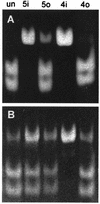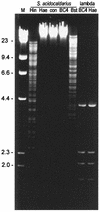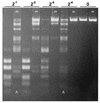Cytosine methylation by the SuaI restriction-modification system: implications for genetic fidelity in a hyperthermophilic archaeon
- PMID: 12867480
- PMCID: PMC165766
- DOI: 10.1128/JB.185.15.4657-4661.2003
Cytosine methylation by the SuaI restriction-modification system: implications for genetic fidelity in a hyperthermophilic archaeon
Abstract
5-methylcytosine in chromosomal DNA represents a potential source of frequent spontaneous mutation for hyperthermophiles. To determine the relevance of this threat for the archaeon Sulfolobus acidocaldarius, the mode of GGCC methylation by its restriction-modification system, SuaI, was investigated. Distinct isoschizomers of the SuaI endonuclease were used to probe the methylation state of GGCC in native S. acidocaldarius DNA. In addition, the methylation sensitivity of the SuaI endonuclease was determined with synthetic oligonucleotide substrates and modified natural DNAs. The results show that the SuaI system uses N(4) methylation to block cleavage of its recognition site, thereby avoiding the creation of G. T mismatches by spontaneous deamination at extremely high temperature.
Figures




References
-
- Aravalli, R. N., and R. A. Garrett. 1997. Shuttle vectors for hyperthermophilic archaea. Extremophiles 1:183-191. - PubMed
-
- Cohen, R. M., and R. Wolfenden. 1971. The equilibrium of hydrolytic deamination of cytidine and N4-methylcytidine. J. Biol. Chem. 246:7566-7568. - PubMed
-
- Cooper, D. N., and H. Youssoufian. 1988. The CpG dinucleotide and human disease. Hum. Genet. 78:151-155. - PubMed
-
- Coulondre, C., J. H. Miller, P. J. Farabaugh, and W. Gilbert. 1978. Molecular basis of substitution hot spots in Escherichia coli. Nature 274:775-780. - PubMed
-
- Ehrlich, M., K. F. Norris, R. Y. Wang, K. C. Kuo, and C. W. Gehrke. 1986. DNA cytosine methylation and heat-induced deamination. Biosci. Rep. 6:387-393. - PubMed
Publication types
MeSH terms
Substances
LinkOut - more resources
Full Text Sources
Other Literature Sources
Molecular Biology Databases

